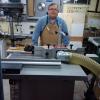I'm running boards through a Dewalt 735, taking 1/4 turn per pass. Everything is fine until the handle on the wheel reaches about 270 degrees. At that point the planer head slowly starts creeping lower, making the depth of cut greater. It seems the vibration, combined with the weight of the handle, is the culprit. I watched it happen.
Is there any way to tighten this thing so the head will stop self-lowering? Or do I have to lock it in place by some other means?




 Reply With Quote
Reply With Quote






